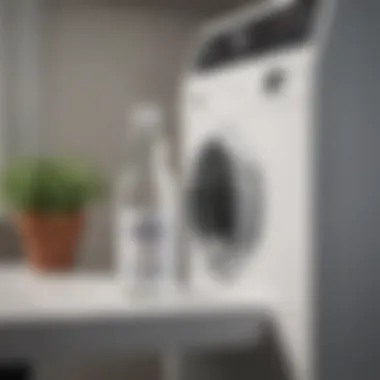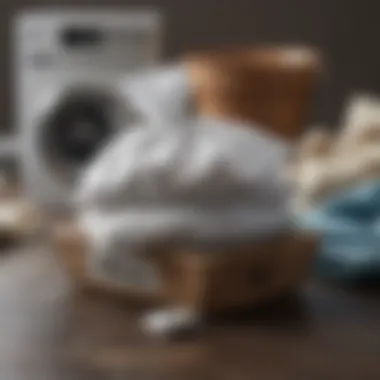Eliminate Detergent Smell from Clothes Effectively


Intro
A common annoyance for many homeowners is the lingering odor of detergent in freshly cleaned clothes. This issue is often overlooked and can detracts from the satisfaction of having clean laundry. Understanding the causes is essential for addressing the problem effectively.
Detergent smells might stem from various factors, including the type of detergent used, washing machine maintenance, or improper rinsing techniques. These odors not only affect the appeal of clothing but can also lead to discomfort for those with sensitivities to fragrances.
This guide will provide practical solutions and insights for ensuring that clothing remains fresh and pleasant after washing. By explaining specific methods for eliminating detergent smells, we hope to enhance your laundry experience.
Key Points to Discuss
- Identification of Causes: Understanding why detergent smell occurs is the first step to finding a solution.
- Effective Treatment Methods: Various household remedies and techniques that effectively combat these odors.
- Preventive Measures: Tips that help avoid detergent smell in the future.
- Fabric Care Tips: Guidance on caring for different types of fabrics to prolong their freshness.
By addressing these areas, this comprehensive guide aims to empower readers with knowledge and practical tools for better laundry practices.
Understanding Detergent Odor
Understanding the odor that detergent leaves on clothes is crucial for any homeowner who values the freshness and cleanliness of their laundry. This section will delve into the underlying factors that contribute to detergent smell, revealing how these factors can impact fabric longevity and personal comfort. Having a grasp on the elements that lead to this unwanted odor not only aids in selecting effective solutions but also fosters better laundry habits.
What Causes Detergent Smell
Several reasons lead to the detergent smell lingering on fabrics. The primary cause is the build-up of detergent residues. When too much detergent is used, or it is not rinsed properly, these residues remain in the fibers of the clothes, creating a persistent smell. The smell can also be attributed to certain components within the detergent itself, such as fragrances, which may not wash out completely.
Furthermore, washing at low temperatures may not adequately dissolve or rinse away these residues, allowing them to cling to the fabric. Consequently, the efficiency of modern washing machines—particularly front-loading styles—can contribute to this issue, as they use less water and may not rinse thoroughly enough.
The Role of Fabric Type
The type of fabric plays a notable role in how odors are absorbed and released. Natural fibers like cotton or wool can often trap more residues compared to synthetic fibers such as polyester. These natural fabrics are more porous, which means they can hold onto the detergent smell much longer. Synthetic fabrics, on the other hand, tend to repel water and residues, making them less prone to odor retention.
Moreover, some fabrics are treated with specific finishes and coatings that can react with certain detergents, leading to unexpected odors. Understanding the fabric composition is essential when choosing a detergent, as some products are formulated to work better with specific fabrics.
Environmental Factors Affecting Laundry
Environmental elements also have a direct impact on how laundry smells after washing. Humidity, for example, can hinder the drying process. If clothes do not dry properly, residual moisture can promote the growth of mold and mildew, further complicating the smell issue.
Moreover, the water quality in your area—such as hard water, which contains high levels of minerals—can also influence the smell of your freshly laundered clothes. Hard water can interact with detergent and prevent it from performing optimally, potentially leaving behind residues and odors.
In summary, understanding these factors provides a solid foundation for tackling the issue of detergent smell. A focus on the causes, fabric types, and environmental influences provides readers a well-rounded perspective on how to achieve cleaner and fresher laundry.
Identifying the Problem
Identifying the issue of detergent smell in clothing is critical for any homeowner aiming for fresh laundry. When laundry does not smell clean, it can lead to frustration and disappointment. This section focuses on pinpointing the causes behind the odor. Understanding these factors can help readers develop informed and effective strategies for elimination.
Recognizing Detergent Build-Up
A common first step is to recognize if there is detergent build-up on clothes. This often occurs when too much detergent is used in each load, not allowing it to rinse away completely. Over time, this can lead to a residue that clings to fabrics and fosters odors. Signs of buildup include clothes that feel sticky or have a faint detergent aroma despite being washed. Additionally, towels may lose absorbency.
To address this problem, it is essential to evaluate the amount of detergent one uses.
- Standard Usage: Most products provide guidelines based on load size or soil level.
- Dilution Effects: Using undiluted liquid detergent can worsen the problem, leading to buildup.


Monitoring the washing machine’s performance can help too. Checking water levels and ensuring it rinses properly are crucial steps. If an excess is noted in one wash, it will affect subsequent washes.
Distinguishing Between Detergent and Other Odors
Differentiating between detergent smell and other odors is vital for proper diagnosis. Detergent odors usually have a chemical or artificial scent, while others may be more organic or musty. For instance, mildew is a prevalent odor that occurs when clothes remain wet for excessive periods. This type of smell can also be the result of a dirty washing machine.
To identify the source accurately, consider these aspects:
- Visual Inspection: Examine the clothes for any stains or mold.
- Handling Technique: Smell the fabric directly after it comes out of the wash.
- Further Cleanliness Check: Evaluate if the smell persists after drying.
Understanding how to distinguish odors helps in tailoring the solution effectively. By knowing whether to address detergent residue or another source, one can optimize the cleaning process accordingly.
Practical Solutions for Removal
Addressing the persistent issue of detergent smell on clothes demands effective and practical solutions. These solutions not only aim to eliminate the odor but also enhance the overall freshness and cleanliness of your laundry. Furthermore, implementing these techniques can lead to better fabric longevity. It is crucial to consider how certain methods suit different clothing types and washing machines, ensuring a tailored approach for optimal results.
Washing with Baking Soda
Baking soda proves to be a powerful ally in the fight against detergent scent. Its natural properties help neutralize odors, creating a fresh environment for your clothes. When used during the wash cycle, it can absorb lingering smells that ordinary detergents may leave behind.
To utilize baking soda effectively, follow these simple steps:
- Add half a cup of baking soda to your washing machine, along with your regular laundry detergent.
- Set the washing machine to a suitable cycle considering the type of fabric.
- Once the wash is complete, inspect your clothes for any residual odor.
Baking soda not only combats detergent smell but also softens clothes, contributing to a more pleasant wear. Ensure that you only use it in moderation to prevent any potential residue buildup, which can affect the next wash.
Using Vinegar in the Rinse Cycle
Vinegar serves as another excellent remedy for removing unwanted odors. Its acidity works effectively to cut through detergent residues that can cling to fabrics. This method not only refreshes your garments but also aids in maintaining their color vibrancy and overall appearance.
To incorporate vinegar into your washing routine, follow these guidelines:
- Use white distilled vinegar as it is odor-free and effective.
- Add one cup of vinegar during the rinse cycle instead of your usual fabric softener.
- Avoid combining vinegar with bleach, as this can result in harmful fumes.
This method can help in achieving a cleaner, fresher laundry result. The slight odor of vinegar dissipates quickly, leaving clothes smelling neutral and fresh.
Rewashing Clothes with Minimal Detergent
Sometimes, a simple rewash can greatly improve the freshness of clothing. This method is especially useful for items that have been washed but still carry the scent of detergent. Reducing the amount of detergent in the second wash helps to minimize the scent further.
To rewash effectively:
- Choose a gentle or short wash cycle to prevent unnecessary wear on fabrics.
- Use only a small amount of detergent or consider omitting it entirely if the clothes are not heavily soiled.
- Consider washing in cold water, as it can be less aggressive and helps to maintain fabric quality.
This technique is a straightforward yet effective approach, ensuring that the accumulated detergent odors are significantly reduced. It acts as a good practice for maintaining clothing freshness without excessive detergent use.
Additional Techniques for Freshness
In the pursuit of eliminating detergent odors from clothes, it is essential to adopt additional techniques that go beyond the basic washing process. These supplementary practices enhance the overall freshness of laundry, making them noteworthy for homeowners and fabric care enthusiasts. Utilizing these methods can lead to a significant improvement in how fabrics smell, allowing clothing to retain a clean, pleasant scent long after washing.
Air Drying Clothes Outdoors


Air drying clothes outdoors offers natural benefits that can significantly help in removing detergent smells. The process exposes fabrics to fresh air and sunlight, which can break down residue left by detergents. Sunlight is a powerful disinfectant and can eliminate bacteria that contribute to unpleasant odors. Moreover, air drying leaves clothes feeling crisp and fresh.
There are several considerations to keep in mind when air drying clothes:
- Select sunny days: Sunlight is more effective at eliminating odors. If it is cloudy, the drying process may take longer, and dampness may lead to musty smells.
- Avoid pollens and allergens: During pollen season, it might be best to air dry clothes indoors if you are sensitive to allergies.
- Opt for good ventilation: If drying indoors, ensure that the space is well-ventilated to avoid trapped moisture.
By adopting air drying as a regular practice, the freshness of clothes can be maintained while minimizing reliance on chemical fragrances found in commercial fabric softeners.
The Impact of Dryer Sheets
Dryer sheets are commonly used to enhance fabric softness and reduce static cling. However, their impact on detergent odors can be mixed. While they do provide a pleasant scent that can mask undesirable odors, there is a potential downside: some dryer sheets can leave behind a film that combines with detergent residues, thus perpetuating the smell.
To effectively use dryer sheets without reinforcing odors:
- Choose unscented varieties: This can reduce the chance of conflicting scents and may help in eliminating residual smells.
- Limit their usage: Using them sparingly or alternating with air drying could prevent over-dependence on artificial fragrances.
- Opt for natural alternatives: Wool dryer balls or bamboo fabric softener alternatives can reduce static and soften clothes without introducing additional scents.
Understanding the cautious application of dryer sheets is necessary for maintaining freshness in laundry without contributing to odor issues.
Avoiding Overloading the Washer
Overloading the washing machine is a common practice, usually done to save time and energy. However, this habit can lead to several problems, including ineffective cleaning and increased detergent retention. When a washer is overloaded, clothes do not have enough room to move freely, leading to improper rinsing.
Key points to consider include:
- Follow manufacturer instructions: Always adhere to the capacity limits recommended by your washing machine's manufacturer.
- Separate laundry loads: Consider separating items by fabric type and weight, as heavier items can trap detergent in lighter fabrics.
- Monitor load conditions: If clothes come out feeling soapy or retain an odor, it is a clear sign of overloading, indicating that the washer could not rinse properly.
By avoiding overloading, users can enhance the efficiency of their laundry routines, ensuring that detergent and potential odors are removed effectively.
Long-Term Preventative Measures
Long-term preventative measures are essential for maintaining the freshness of your laundry and ultimately preventing the laundry from developing a detergent smell. Unlike quick fixes, these measures focus on sustainable habits and practices that can significantly reduce the likelihood of odors returning. It’s important for homeowners and individuals who frequently do laundry to understand that taking proactive steps can lead to a more satisfying laundry experience.
Choosing the Right Detergent
Selecting the appropriate detergent is crucial in the battle against unwanted odors. Not all detergents are equal; some are formulated specifically to tackle odor-causing residues. Look for detergents labeled as "free & clear," which typically do not contain heavy fragrances and harsh chemicals. This translates to fewer residues left on fabrics after washing.
- Consider Your Needs: People with sensitive skin may prefer hypoallergenic options which contain less scent and less potential for irritation.
- Check Ingredients: Environmental considerations can be important as well. Choose biodegradable or eco-friendly detergents that don’t leave a harmful trace on fabrics and local water systems.
Proper Storage of Laundry Products
Storing your laundry products correctly can also impact their effectiveness and your laundry’s freshness. Ideally, laundry products should be kept in a cool, dry place, away from direct sunlight and humidity.
- Seal Containers: Ensure that detergents and any other laundry aids are tightly sealed. Exposure to air can lead to changes in the product that might reduce effectiveness.
- Date Your Products: Keep an eye on expiration dates. Old or improperly stored laundry products can lose their cleaning power, leaving residues that could contribute to unwanted smells.
Maintaining Washing Machine Hygiene
The washing machine itself is a significant factor in preventing detergent odor. A dirty machine can contribute to unpleasant smells, as leftover detergent and fabrics break down can produce bacteria and mold. Regular cleaning of your washing machine is imperative for optimal performance.
- Run Regular Cleaning Cycles: Many modern machines come with a cleaning cycle. Use it every month or so with a machine cleaner or a simple mix of baking soda and vinegar this helps remove buildup.
- Leave the Door Open: After a wash, leave the washing machine door ajar for some time to allow moisture to escape and to prevent mold growth.
Pro Tip: Regular maintenance and the right product choices form the backbone of an effective laundry strategy that reduces odors while enhancing the life and appearance of fabrics.


By integrating these long-term preventative measures into your laundry routine, you stand a better chance against persistent detergent smells. Ultimately, the goal is to maintain the quality of your fabrics and prevent any build-up that could lead to unpleasant odors.
Addressing Special Fabrics
Addressing special fabrics is crucial in ensuring laundry care is effective and appropriate. Fabrics such as silk, wool, and those materials labeled as performance wear require different handling compared to standard cotton or polyester blends.
These materials often have specific washing and drying requirements to maintain their integrity and look. Incorrect treatment can lead to damage, shrinking, or discoloration. Hence, understanding how to care for these fabrics helps prolong their lifespan, keeping them in good shape. For homeowners and meticulous individuals, mastering these techniques not only preserves the aesthetic appeal of garments but also avoids the common issue of detergent smell lingering in these specialty items.
Care Tips for Delicate Fabrics
When dealing with delicate fabrics like silk or lace, it is essential to adopt a gentler approach.
- Hand Wash: Opt for hand washing instead of machine washing whenever possible. This reduces the risk of damage from agitation.
- Use Cold Water: Cold water helps to prevent fabric shrinkage and color fading, which is crucial for maintaining delicate textiles.
- Gentle Detergent: Always choose a detergent that is specifically formulated for delicate fabrics. These products are usually lighter on chemical elements and are less likely to leave residual odors.
- Avoid Bleach: Harsh chemicals like bleach can ruin delicate fabrics. Instead, consider natural alternatives like lemon juice for gentle stain removal.
- Air Dry: After washing, lay the fabric flat or hang it to air dry. This helps prevent stretching and maintains the fabric texture, which is particularly important for delicate materials.
Handling Sportswear and Performance Fabrics
Sportswear and performance fabrics, such as those made for athletic purposes, require special attention as well. These materials are designed to wick moisture away from the body and often include specific technology that can be compromised by improper washing. Therefore, following these tips can prevent odor buildup and maintain functionality:
- Follow Care Labels: Always adhere to washing instructions on the label. Performance fabrics may have unique requirements.
- Moisture-Wicking Properties: Use detergents that preserve the moisture-wicking features. Standard detergents may leave a residue that enhances odor retention.
- Wash Separately: It’s best to avoid mixing sportswear with heavier items like towels or jeans to reduce friction and potential fabric damage.
- Dryer Settings: When drying, use a low or no-heat setting. High temperatures can damage elastic fibers and other materials in performance wear.
Remember, proper care for special fabrics not only helps eliminate detergent smells but also ensures that the fabrics serve their purpose effectively and last longer.
Exploring Professional Services
When faced with persistent detergent smells in your clothes, exploring professional laundry services can be a viable option. While many homeowners are equipped to handle their own laundry issues, there are instances when professional help is essential. Understanding the benefits of these services, along with the specific conditions that warrant such a decision, is key to achieving optimal results in fabric care.
When to Seek Professional Help
Knowing when to engage professional cleaning services can save time and ensure the longevity of your garments. You may consider reaching out for assistance when:
- Odor Persists After Home Remedies: If methods such as vinegar rinses or baking soda washing fail to eliminate the smell, it may indicate a deeper issue.
- Fabric Composition: Delicate fabrics like silk or wool require specialized care. Professionals are trained to treat such materials effectively without causing damage.
- High-Volume Laundry Needs: For those managing large loads or services needing consistent care, a professional service provides efficiency.
- Unusual Stains or Odors: Sometimes, the odor might not purely stem from detergent but could be related to other factors like mildew. In such cases, experts possess the right products and techniques to address complex issues.
Types of Professional Cleaning Services Available
Numerous professional services cater to different fabric types and laundry needs. Here are some common options:
- Dry Cleaning: Ideal for garments that cannot be washed in water. It uses solvents to clean and is suitable for suits, delicate dresses, and fabrics that may shrink or get damaged in a washing machine.
- Steam Cleaning: Often used for upholstery and some fabric types, this method utilizes steam to eliminate odors and sanitize without harsh chemicals.
- Laundry Pickup and Delivery Services: These have gained popularity for convenience. They minimize effort by picking up dirty laundry and returning it cleaned and folded, often utilizing environmentally friendly methods.
- Specialized Odor Removal Services: A niche offering that focuses on removing specific odors from fabrics, such as smoke or mildew. They may employ advanced techniques like ozone treatment to neutralize stubborn smells.
"Engaging professional services not only saves time but also ensures that fabrics receive the appropriate care they need, preserving their integrity over many washes."
Choosing the right service depends on your specific needs, fabric types, and the severity of the odor problem. Understanding these elements will guide homeowners or laundry enthusiasts in making informed decisions.
Culmination
The conclusion is a very important part of this article. It brings together all the points discussed. Understanding how to eliminate detergent smell from clothes not only enhances your laundry experience, but also improves how your clothes feel against the skin. Many readers face this problem, and it can lead to frustration. The solutions provided are practical and can be incorporated into everyday laundry routines. A clean and fresh smell is a sign of well cared for fabrics.
Summary of Key Points
To summarize, there are several key points regarding detergent odors:
- Understanding Detergent Odor: It is essential to know the causes of the smells.
- Identifying the Problem: Recognizing if you have a build-up or if another odor is masking detergent smell is crucial.
- Practical Solutions: Using baking soda, vinegar, or minimal detergent when rewashing can tackle unwanted scents effectively.
- Additional Techniques: Simple methods like air drying clothes outdoors can help ensure freshness.
- Long-Term Measures: Choosing the right detergent and maintaining washing machine hygiene can prevent odor from accumulating in the first place.
- Special Fabrics: Different fabrics require their own specific care tips to handle odors properly.
- Professional Services: In some cases, it may be necessary to seek outside help for tougher odors.
Final Thoughts on Fabric Care
Fabric care goes beyond just removing odors. It involves knowing how to take care of different materials, the importance of using appropriate products, and being mindful of the laundering process. Each fabric type has unique needs. Therefore, being informed can prolong the life of your clothing.
In summary, a holistic approach to laundry can lead to more effective and satisfying results. Your journey to keeping your clothes smelling fresh is achievable with the right techniques. Always remember that prevention is better than cure. Pay attention to the products you use and the way you handle your laundry to promote a fresh and odor-free wardrobe.















